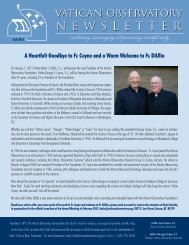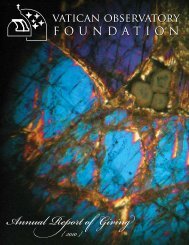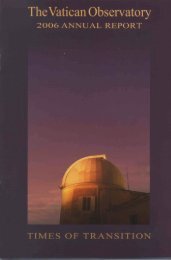Annual Report 2003 - Vatican Observatory
Annual Report 2003 - Vatican Observatory
Annual Report 2003 - Vatican Observatory
Create successful ePaper yourself
Turn your PDF publications into a flip-book with our unique Google optimized e-Paper software.
the small asteroid Vesta) are roughly 40% plagioclase, while the proportion of plagioclasein the lunar Fra Mauro basalts can range up to 65%, implying that they have seen awider range of source region initial pressures or compositions. If this trend holds for theMars-sized impactor Theia, its initial crustal material (and hence the initial lunar composition)should have been even richer in plagioclase.Lunar primordial magmas, formed by remelting this crustal material from Theia underdifferent lunar conditions, should produce basalts whose composition would exhaust pyroxenebefore plagioclase. Thus further melting would result in the production of anorthosites(instead of the orthopyroxenites seen in the Martian and Vesta meteorites). Thismechanism provides a more geophysically reasonable way to make anorthosites than theproblematic “floating anorthosite crust” first proposed for the Moon thirty years ago.Further developments of this model hold promise to explain anomalies in both theApollo-era lunar seismic data, and the compositions of outcrops in the South Pole-Aikenbasin measured by the Lunar Prospector and Clementine missions.• Lunar Meteorite Trace Elements: As mentioned above, one of the spurs to reevaluatingorigin models for the Moon is recognition that certain meteorites in our collectionsare lunar samples delivered to Earth by impacts on the surface of the Moon.Unlike Apollo samples, we do not know exactly where on the lunar surface these lunarmeteorites came from, but almost certainly they sample more areas than the narrow regionof flat, equatorial, near-side plains that Apollo and Luna landers visited.Several such lunar meteorites, first discovered in the Sahara desert, have been donatedto the <strong>Vatican</strong> <strong>Observatory</strong> collection in recent years. These include samples of Dar alGani 400, Northwest Africa 482, and Dhofar 081. All three are chemically similar tohighland anorthosites (rocks dominated by calcium-rich plagioclase, called anorthite).From the Apollo samples, we know that such rocks are are among the oldest on theMoon. But since being formed, these meteorites have all been severely reworked by extensiveshocks, presumably due to impacts including (but not limited to) the crateringevent that launched the samples off the Moon’s surface. Because of these shocks, at presentthe rocks consist of a very dark fine-grained matrix surrounding small white glassyor microcrystalline veins and clasts.In the past year RUSSELL and JEFFRIES (Natural History Museum, London) havedone extensive measurements of major and trace element abundances of fragments fromthese samples. In collaboration with them, CONSOLMAGNO has used these data tocalculate the bulk mineralogy that the clasts and matrix had before the mineral structurewas destroyed by shock. From knowing how the trace elements, especially the RareEarth Elements (REE), partition themselves between any given mineral and the magmafrom which the mineral is crystallizing, it is then possible to calculate the likely compositionof the melt from which these rocks first formed.23ANNUAL REPORT <strong>2003</strong>







